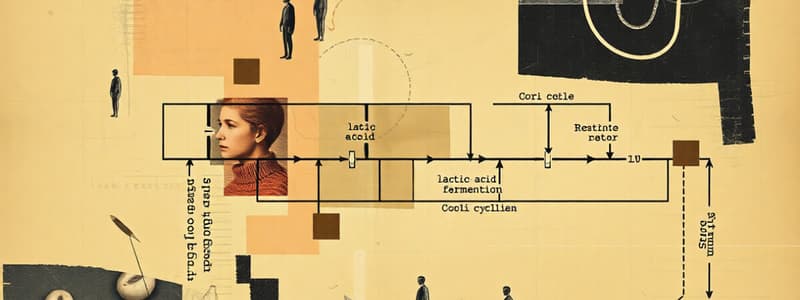Podcast
Questions and Answers
What is produced during the oxidative phase of the Pentose Phosphate Pathway?
What is produced during the oxidative phase of the Pentose Phosphate Pathway?
- ATP and G-6-P
- ADP
- NADPH and a Pentose (correct)
- R-5-P and CO2
Which statement correctly describes glycolysis?
Which statement correctly describes glycolysis?
- It yields less than 500 kJ/mol of glucose.
- Glycolysis does not occur in aerobic conditions.
- Glycolysis occurs only in plant cells.
- Pyruvate is the end product of glycolysis. (correct)
Which pathway is primarily responsible for generating NADPH?
Which pathway is primarily responsible for generating NADPH?
- Gluconeogenesis
- Pentose Phosphate Pathway (correct)
- Glycolysis
- Citric Acid Cycle
What is the end product of glycolysis under anaerobic conditions?
What is the end product of glycolysis under anaerobic conditions?
In the Pentose Phosphate Pathway, what does the nonoxidative phase regenerate?
In the Pentose Phosphate Pathway, what does the nonoxidative phase regenerate?
What is the role of hexokinase in relation to glucose affinity?
What is the role of hexokinase in relation to glucose affinity?
What does a high Km value indicate about an enzyme's affinity?
What does a high Km value indicate about an enzyme's affinity?
How does the increase in reactants affect product formation?
How does the increase in reactants affect product formation?
What are the possible fates of pyruvate under anaerobic conditions?
What are the possible fates of pyruvate under anaerobic conditions?
Which molecule must be reoxidized for glycolysis to continue?
Which molecule must be reoxidized for glycolysis to continue?
What is the primary purpose of gluconeogenesis?
What is the primary purpose of gluconeogenesis?
What happens when there is an increase in product concentration?
What happens when there is an increase in product concentration?
What is the result of using ATP in the cell during energy-requiring processes?
What is the result of using ATP in the cell during energy-requiring processes?
What is the primary reason glucose-dependent cells, such as RBCs, cannot undergo oxidative phosphorylation?
What is the primary reason glucose-dependent cells, such as RBCs, cannot undergo oxidative phosphorylation?
How does glucagon affect fructose 2,6-bisphosphate levels during fasting?
How does glucagon affect fructose 2,6-bisphosphate levels during fasting?
Why can't the brain utilize amino acids during prolonged fasting?
Why can't the brain utilize amino acids during prolonged fasting?
What triggers gluconeogenesis when glucose levels are low?
What triggers gluconeogenesis when glucose levels are low?
Which of the following is a precursor for gluconeogenesis?
Which of the following is a precursor for gluconeogenesis?
What role do glucogenic amino acids play in metabolism?
What role do glucogenic amino acids play in metabolism?
Why can animals not convert fatty acids into glucose?
Why can animals not convert fatty acids into glucose?
Which steps in glycolysis are irreversible and cannot be easily reversed for gluconeogenesis?
Which steps in glycolysis are irreversible and cannot be easily reversed for gluconeogenesis?
In which part of the body does gluconeogenesis primarily occur?
In which part of the body does gluconeogenesis primarily occur?
During the energy use of the heart muscle, what is expected to activate phosphofructokinase 1?
During the energy use of the heart muscle, what is expected to activate phosphofructokinase 1?
Which enzyme is primarily responsible for the conversion of pyruvate to oxaloacetate?
Which enzyme is primarily responsible for the conversion of pyruvate to oxaloacetate?
Which compound cannot be synthesized from acetyl-CoA in animals?
Which compound cannot be synthesized from acetyl-CoA in animals?
What is a significant disadvantage of gluconeogenesis?
What is a significant disadvantage of gluconeogenesis?
During gluconeogenesis, which compound is NOT an end product?
During gluconeogenesis, which compound is NOT an end product?
What is the main reason that gluconeogenesis is not simply a reversal of glycolysis?
What is the main reason that gluconeogenesis is not simply a reversal of glycolysis?
Which of the following statements about ATP generation in gluconeogenesis is true?
Which of the following statements about ATP generation in gluconeogenesis is true?
Which of the following amino acids are classified as glucogenic?
Which of the following amino acids are classified as glucogenic?
What is the primary role of glycerokinase in gluconeogenesis?
What is the primary role of glycerokinase in gluconeogenesis?
Which of the following statements about Acetyl-CoA is correct?
Which of the following statements about Acetyl-CoA is correct?
What metabolic pathway is activated by fructose-1,6-bisphosphatase?
What metabolic pathway is activated by fructose-1,6-bisphosphatase?
Which cofactor is necessary for propionyl CoA carboxylase to function?
Which cofactor is necessary for propionyl CoA carboxylase to function?
Which of the following is true regarding the regulation of gluconeogenesis?
Which of the following is true regarding the regulation of gluconeogenesis?
What is the end product of the conversion of methyl malonyl CoA in gluconeogenesis?
What is the end product of the conversion of methyl malonyl CoA in gluconeogenesis?
How is glycerol converted into an intermediate that can enter glycolysis?
How is glycerol converted into an intermediate that can enter glycolysis?
Flashcards are hidden until you start studying
Study Notes
Lactic Acid Fermentation
- Involves the conversion of carbohydrates into lactic acid, primarily by certain bacteria and fungi.
- Plays a critical role in energy production under anaerobic conditions.
Cori Cycle
- A metabolic pathway that recycles lactate produced during anaerobic glycolysis back to glucose in the liver.
Pentose Phosphate Pathway (PPP)
- Functions as an alternative to glycolysis, generating NADPH and ribose-5-phosphate for nucleotide synthesis.
- Two main phases:
- Oxidative phase produces NADPH and a pentose sugar.
- Non-oxidative phase regenerates glucose-6-phosphate from ribose-5-phosphate.
- Significant connection to NADPH in combating oxidative stress.
- Clinical relevance highlighted by glucose-6-phosphate dehydrogenase (G6PD) deficiency.
Glycolysis Review
- Central metabolic pathway for glucose oxidation across all tissues, yielding approximately -2840 kJ/mol of energy.
- Glucose is essential for energy production and serves as a precursor for various metabolic pathways.
- Results in the production of pyruvate as the end product.
- Key outputs include:
- 4 ATP, needed for energy-requiring cellular processes.
- 2 NADH, which must be reoxidized to continue glycolysis.
Regulation of Glycolysis
- Heavily regulated to ensure effective nutrient use and ATP production.
- Hexokinase is characterized by higher affinity for glucose; high Km values indicate low affinity.
Gluconeogenesis
- Synthesizes glucose from non-carbohydrate precursors to supply glucose-dependent cells (e.g., RBCs).
- Vital during prolonged fasting, particularly for brain function which relies predominantly on glucose.
- Energetically expensive, operating primarily in the liver.
Pyruvate Fates
- Under anaerobic conditions, pyruvate can convert to either lactate or ethanol (not in humans).
- Transformation of pyruvate is contingent on environmental oxygen levels.
Gluconeogenesis Precursors
- Uses lactate, pyruvate, and oxaloacetate as substrates.
- Glucogenic amino acids contribute by entering the citric acid cycle.
- Fatty acids cannot be converted into glucose due to their metabolism producing acetyl-CoA, which cannot yield oxaloacetate.
Differences Between Glycolysis and Gluconeogenesis
- Their pathways are thermodynamically favorable, but they operate in reverse directions.
- Involves several key enzymes that facilitate irreversible steps of glycolysis to form glucose.
Enzymes in Gluconeogenesis
- Notable enzymes include:
- Pyruvate carboxylase converts pyruvate to oxaloacetate.
- Phosphoenolpyruvate carboxykinase (PEPCK) further converts oxaloacetate to phosphoenolpyruvate.
- Fructose-1,6-bisphosphatase regulates the conversion of fructose-1,6-bisphosphate to fructose-6-phosphate.
Reciprocal Regulation
- Generally regulated by fluctuations in metabolites; increases in reactants stimulate product formation, while increases in products can inhibit further synthesis.
- Key regulatory elements include citrate (activating gluconeogenesis) and AMP (inhibiting it), reflecting energy status in the cell.
Additional Gluconeogenesis Sources
- Glycerol, released from adipose tissue, can be converted to glucose; the process includes enzymes like glycerokinase and glycerol-3-phosphate dehydrogenase.
- Propionate from odd-chain fatty acids and certain amino acids can also enter gluconeogenesis through conversion to succinyl-CoA before producing glucose.
Studying That Suits You
Use AI to generate personalized quizzes and flashcards to suit your learning preferences.




